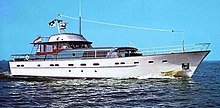2182 kHz

The frequency 2182 kHz is a radio frequency of the maritime radio service . The frequency was set as a binding call and emergency call frequency with the SOLAS agreement in 1948. The frequency served as a radiotelephone supplement for the radio telegraphy frequency of 500 kHz . Originally, amplitude modulation was used , but from 1973 single sideband modulation (SSB) in the upper sideband (USB) was increasingly used . Before the introduction of VHF channel 16 (156.800 MHz), the frequency, along with the medium wave frequency 500 kHz, was the most important frequency for seagoing ships and had to be monitored with a watch receiver on the bridge of a ship. Nowadays, the frequency 2187.5 kHz takes over this task, which works with Digital Selective Calling (DSC) , an automatic telex process that enables ship data, location and other information to be transmitted in an emergency call, while frequency 2182 is designed as a radio frequency was. The frequency is part of the border wave in Germany and of the medium wave in English-speaking countries . With the frequency, a range between 500 and 1000 kilometers could be achieved. On the frequency, radio silence had to be observed from the full hour to the 3rd minute and from the 30th to the 33rd minute . This radio silence was necessary so that even weak signals, e.g. B. from lifeboats could be received. Originally, the frequency was monitored by all border and shortwave coastal radio stations such as Norddeich Radio or Kiel Radio . With the full implementation of the Global Maritime Distress and Safety System (GMDSS), the obligation to eavesdrop on this frequency expired and many coast stations ceased to watch on this frequency. The obligation to intercept this frequency for ships that were equipped with GMDSS selective call procedures also expired. In principle, this meant the end of the profession of radio officer or marine radio operator, as the radio operator could be replaced by automated systems. Although the frequency has lost its importance as an emergency frequency, it is still used to deal with emergencies at sea. Rescue ships approaching must contact the disturbed vessel on this frequency. In the event of an emergency at sea, all transmissions that are not used for rescue measures must be avoided.
Emergency call
There was a standardized procedure for sending an emergency call, which was checked in the tests for issuing a marine radio certificate. Example of an emergency call: “Mayday Mayday Mayday This is Seemöwe Seemöwe Seemöwe (fictional ship name) Delta Alpha Foxtrot Golf (fictitious call sign ) Mayday position xxx xxx, we are sinking, manning lifeboat Mayday (press the microphone button for at least 10 seconds to get a bearing for ships All listening radio stations had to acknowledge receipt of the broadcast or could repeat the emergency call with Mayday Relay. This function was usually taken over by the coast radio stations.
Radiotelephone alarm signs
Since eavesdropping on the frequency of 2182 kHz on the bridge was often found to be annoying, many bridges were equipped with a safety receiver that only activated the loudspeaker when it received a radio alarm signal. The radio alarm signal consisted of two alternating sinusoidal tones of 2200 Hz and 1300 Hz over a period of one minute. The tones were changed every 250 milliseconds. Only after receiving such a message was the recipient's loudspeaker activated. At the same time, an alarm signal was given in the ship's radio room and in the radio officer's chamber. Alarm signaling devices were mandatory on ships of a certain size.
Calls
The frequency was also used to call ships. Coastal radio stations in particular announced existing telephone calls and telegrams. The actual radio traffic took place on other frequencies (these were called working frequencies). Example of a broadcast: "All ships all ships all ships this is Norddeich Radio. Norddeich Radio is at all radio stations, at all radio stations here. We have traffic for the following stations There is traffic for (a list of radio call signs and ship names followed) Norddeich Radio is listening on, Norddeich Radio is listening on the following frequencies (a list of bands or frequencies followed). Here Norddeich Radio is the end of the collective call. ”Collective calls were regularly sent out, mostly every hour. Weather reports, such as storm warnings and nautical messages, such as the extinction of a radio beacon or a lighthouse, were also announced on this frequency. The actual message was read out on a working frequency.
See also
Individual evidence
- ^ Contact at Sea: A History of Maritime Radio Communications Peter B. Schroeder
- ↑ International Convention for the Savety of Life at Sea (1948)
- ^ NOAA National Weather Service Marine Forecasts
- ↑ United States Coast Guard Coast Guard Termination of its 2 MHZ distress watchkeeping service
- ↑ Coast station Norddeich Radio - Timetable from 1979 to 1998 : December 31, 1996 shutdown of the distress frequency 2182 kHz, takeover of the distress observation for the German Bight by the Danish coast radio station, at the same time the switching of calls to border waves
- ^ RNZN Communicators Association A listening watch aboard GMDSS-equipped ships on 2182 kHz ended on February 1, 1999
- ^ Cyprus Joint Rescue Coordination Center
- ↑ United States Coast Guard The radiotelephone distress signal consists of the word MAYDAY spoken three times. This signal indicates that a marine mobile station is threatened by GRAVE AND IMMINENT danger and requests immediate assistance.



